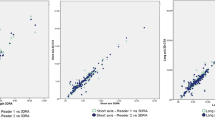Abstract
Purpose
Accurate and reliable measurement of aneurysm size is important for treatment planning. The purpose of this study was to determine intraobserver and interobserver variability of CTA and MRA for measurement of the size of cerebral aneurysms.
Methods
Thirty patients with 33 unruptured cerebral aneurysms (saccular, >3 mm in their maximal dimension, with no daughter sacs or lobulations) who underwent 256-row multislice CTA, 3-D TOF MRA at 3.0T, and 3D rotational angiography (3DRA) were retrospectively analyzed. Three independent observers measured the neck, height, and width of the aneurysms using the CTA and MRA images. Intraobserver and interobserver variability of CTA and MRA measurements was evaluated using the standardized difference and intraclass correlation coefficient, with 3DRA measurements as the reference standard. In addition, the mean values of the measurements using CTA and MRA were compared with those using 3DRA.
Results
The overall intraobserver and interobserver standardized differences in CTA/MRA were 12.83–15.92%/13.48–17.45% and 14.08–17.00%/12.08–17.67%, respectively. The overall intraobserver and interobserver intraclass correlation coefficients of CTA/MRA were 0.88–0.98/0.84–0.96 and 0.86–0.98/0.85–0.95, respectively. Compared to the height and width measurements, measurements of the neck dimensions showed higher intraobserver and interobserver variability. The sizes of the cerebral aneurysms measured by CTA and MRA were 1.13–9.26 and 5.20–9.67% larger than those measured by 3DRA, respectively; however, these differences were not statistically significant.
Conclusion
There were no noticeable differences between intraobserver and interobserver variability for both CTA- and MRA-based measurements of the size of cerebral aneurysms.
Similar content being viewed by others
Abbreviations
- CTA:
-
Computed tomography angiography
- MRA:
-
Magnetic resonance angiography
- 3DRA:
-
3D rotational angiography
- TOF:
-
Time-of-flight
- SD:
-
Standardized difference
- ICC:
-
Intraclass correlation coefficient
- SAH:
-
Subarachnoid hemorrhage
- VR:
-
Volume rendering
- MIP:
-
Maximum intensity projection
- LOA:
-
Limits of agreement
- CI:
-
Confidence interval
- PC:
-
Phase-contrast
- CE:
-
Contrast enhanced
- SSD:
-
Shaded surface display
- DSA:
-
Digital subtracted angiography
References
Chalouhi N, Hoh BL, Hasan D (2013) Review of cerebral aneurysm formation, growth, and rupture. Stroke 21:296–300
Hochmuth A, Spetzger U, Schumacher M (2002) Comparison of three-dimensional rotational angiography with digital subtraction angiography in the assessment of ruptured cerebral aneurysms. AJNR Am J Neuroradiol 23:1199–1205
van Rooij WJ, Sprengers ME, de Gast AN, Peluso JP, Sluzewski M (2008) 3D rotational angiography: the new gold standard in the detection of additional intracranial aneurysms. AJNR Am J Neuroradiol 29:976–979
Kouskouras C, Charitanti A, Giavroglou C, Foroglou N, Selviaridis P, Kontopoulos V, Dimitriadis AS (2004) Intracranial aneurysms: evaluation using CTA and MRA—correlation with DSA and intraoperative findings. Neuroradiology 46:842–850
Thompson BG, Brown RD Jr, Amin-Hanjani S, Broderick JP, Cockroft KM, Connolly ES Jr, Duckwiler GR, Harris CC, Howard VJ, Johnston SC, Meyers PM, Molyneux A, Ogilvy CS, Ringer AJ, Torner J (2015) Guidelines for the management of patients with unruptured intracranial aneurysms: a guideline for healthcare professionals from the American Heart Association/American Stroke Association. Stroke 46:2368–2400
International Study of Unruptured Intracranial Aneurysms Investigators (1998) Unruptured intracranial aneurysms—risk of rupture and risks of surgical intervention. N Engl J Med 339:1725–1733
Greving JP, Wermer MJ, Brown RD Jr, Morita A, Juvela S, Yonekura M, Ishibashi T, Torner JC, Nakayama T, Rinkel GJ, Algra A (2014) Development of the PHASES score for prediction of risk of rupture of intracranial aneurysms: a pooled analysis of six prospective cohort studies. Lancet Neurol 13:59–66
Forbes G, Fox AJ, Huston J 3rd, Wiebers DO, Torner J (1996) Interobserver variability in angiographic measurement and morphologic characterization of intracranial aneurysms: a report from the International Study of Unruptured Intracranial Aneurysms. AJNR Am J Neuroradiol 17:1407–1415
Lubicz B, Levivier M, François O, Thoma P, Sadeghi N, Collignon L, Balériaux D (2007) Sixty-four-row multisection CT angiography for detection and evaluation of ruptured intracranial aneurysms: interobserver and intertechnique reproducibility. AJNR Am J Neuroradiol 28:1949–1955
Wostrack M, Mielke D, Kato N, Guhl S, Schmidt NO, Maldaner N, Vajkoczy P, Dengler J (2015) Interobserver variability in the characterization of giant intracranial aneurysms with special emphasis on aneurysm diameter and shape. Acta Neurochir 157:1859–1865
Shrout PE, Fleiss JL (1979) Intraclass correlations: uses in assessing rater reliability. Psychol Bull 86:420–428
Parlea L, Fahrig R, Holdsworth DW, Lownie SP (1999) An analysis of the geometry of saccular intracranial aneurysms. AJNR Am J Neuroradiol 20:1079–1089
Kiyosue H, Tanoue S, Okahara M, Hori Y, Nakamura T, Nagatomi H, Mori H (2002) Anatomic features predictive of complete aneurysm occlusion can be determined with three-dimensional digital subtraction angiography. AJNR Am J Neuroradiol 23:1206–1213
Ujiie H, Tachibana H, Hiramatsu O, Hazel AL, Matsumoto T, Ogasawara Y, Nakajima H, Hori T, Takakura K, Kajiya F (1999) Effects of size and shape (aspect ratio) on the hemodynamics of saccular aneurysms: a possible index for surgical treatment of intracranial aneurysms. Neurosurgery 45:119–130
Beck J, Rohde S, El Beltagy M, Zimmermann M, Berkefeld J, Seifert V, Raabe A (2003) Difference in configuration of ruptured and unruptured intracranial aneurysms determined by biplanar digital subtraction angiography. Acta Neurochir 145:861–865
Ramgren B, Siemund R, Nilsson OG, Höglund P, Larsson EM, Abul-Kasim K, Björkman-Burtscher IM (2015) CT angiography in non-traumatic subarachnoid hemorrhage: the importance of arterial attenuation for the detection of intracranial aneurysms. Acta Radiol 56:1248–1255
Wilcock DJ, Jaspan T, Worthington BS (1995) Problems and pitfalls of 3-D TOF magnetic resonance angiography of the intracranial circulation. Clin Radiol 50:526–532
Huston J 3rd, Rufenacht DA, Ehman RL, Wiebers DO (1991) Intracranial aneurysms and vascular malformations: comparison of time-of-flight and phase-contrast MR angiography. Radiology 181:721–730
Kaufmann TJ, Huston J 3rd, Cloft HJ, Mandrekar J, Gray L, Bernstein MA, Atkinson JL, Kallmes DF (2010) A prospective trial of 3T and 1.5T time-of-flight and contrast-enhanced MR angiography in the follow-up of coiled intracranial aneurysms. AJNR Am J Neuroradiol 31:912–918
Doerfler A, Becker W, Wanke I, Goericke S, Oezkan N, Forsting M (2004) Multimodal imaging in the elastase-induced aneurysm model in rabbits: a comparative study using serial DSA, MRA and CTA. Rofo-Fortschr Rontg 176:590–596
Ramachandran M, Retarekar R, Harbaugh RE, Hasan D, Policeni B, Rosenwasser R, Ogilvy C, Raghavan ML (2013) Sensitivity of quantified intracranial aneurysm geometry to imaging modality. Cardiovasc Eng Technol 4:75–86
Singh K, Jacobsen BK, Solberg S, Bønaa KH, Kumar S, Bajic R, Arnesen E (2003) Intra- and interobserver variability in the measurements of abdominal aortic and common iliac artery diameter with computed tomography. The Tromsø study. Eur J Vasc Endovasc Surg 25:399–407
Addis KA, Hopper KD, Iyriboz TA, Liu Y, Wise SW, Kasales CJ, Blebea JS, Mauger DT (2001) CT angiography: in vitro comparison of five reconstruction methods. AJR Am J Roentgenol 177:1171–1176
Gailloud P, Oishi S, Carpenter J, Murphy KJ (2004) Three-dimensional digital angiography: new tool for simultaneous three-dimensional rendering of vascular and osseous information during rotational angiography. AJNR Am J Neuroradiol 25:571–573
Beck J, Rohde S, Berkefeld J, Seifert V, Raabe A (2006) Size and location of ruptured and unruptured intracranial aneurysms measured by 3-dimensional rotational angiography. Surg Neurol 65:18–25
Bescós JO, Slob MJ, Slump CH, Sluzewski M, van Rooij WJ (2005) Volume measurement of intracranial aneurysms from 3D rotational angiography: improvement of accuracy by gradient edge detection. AJNR Am J Neuroradiol 26:2569–2572
Author information
Authors and Affiliations
Corresponding author
Ethics declarations
ᅟ
Funding
No funding was received for this study.
Conflict of interest
The authors declare that they have no conflict of interest.
Ethical approval
All procedures performed in the studies involving human participants were in accordance with the ethical standards of the institutional and/or national research committee and with the 1964 Helsinki Declaration and its later amendments or comparable ethical standards. For this type of study, formal consent is not required.
Informed consent
For this type of study formal consent is not required.
Rights and permissions
About this article
Cite this article
Kim, H.J., Yoon, D.Y., Kim, E.S. et al. Intraobserver and interobserver variability in CT angiography and MR angiography measurements of the size of cerebral aneurysms. Neuroradiology 59, 491–497 (2017). https://doi.org/10.1007/s00234-017-1826-y
Received:
Accepted:
Published:
Issue Date:
DOI: https://doi.org/10.1007/s00234-017-1826-y




